The Black Desert and the White Desert
We have just been out to the Black Desert and the White desert in the western desert - a fabulous trip.
We traveled with a group of good friends – Canadians and Americans – and stayed in a hotel in the town of Bawiti, in the Oasis of Bahariya. It is called the International Hot Springs Hotel – and it was great. It is run by a German, Peter Firth, and his mother and Japanese wife Miharu. I still find it astounding that anyone would see the potential for a hotel of this standard in an area like this oasis. If you think of a group of very simple and poor people, and try to imagine organizing a building of this standard complete with working western plumbing and reliable food – well the difficulties would have floored me at the very first stage.
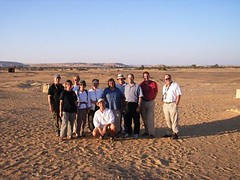
The design of the hotel is beautiful with lots of rooms in unusual shapes – our room was a hexagon, with one side elongated to form the bathroom in the narrower extension.
Best of all is the pool room – and I am not talking about billiards! Every afternoon they fill this freshly with water from the Bahariya hot spring (don’t worry – I am sure the water taken out is used to irrigate the garden or nearby dates). The water comes out of the ground at 40 degrees Celsius – and it is almost painful to get into. I sat on the side with my feet in it and they were tingling in minutes. I didn’t actually swim but those who did said it was wonderful – hot at first, then tingling, then just incredibly relaxing. It is also an unusual colour because of the iron deposits in the area – a rich dark blood red.
We left Cairo at eight in the morning and arrived at the oasis at twelve, with time to check in and have our picnic lunch in the garden. We had planned a tour of the archaeological sites of the area first.
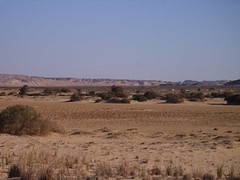
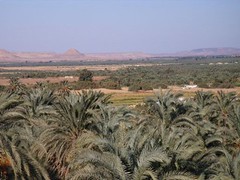
It is still Ramadan and it is really hard to do things in Ramadan. A message came from the guide (organised as a special treat to take us into the tomb of the golden mummies among other things). He was fasting, he was too tired and could not take us. However, he would make the keys available and the hotel manager would guide us instead.
This is a very Egyptian thing to happen. I am not sure what Peter Wirth thought of having to drop everything with a full hotel to take us out, but he and Miharu dropped everything and came. In fact, he was a superb guide. His archaeological knowledge was faultless, and when he didn’t know something he said so and didn’t waffle.
In the museum I quite unknowingly took a photo of part of one of the golden mummies as I was fascinated by the log cabin bandaging on them. The guard stopped me quickly with a ‘no photo’ so I put the camera away. However – I was not altruistic enough to delete the photo – bad, through glass and poorly lit – so here it is! I love the oblique parallelogram block shape and may make a quilt just like this in the same neutrals one day.
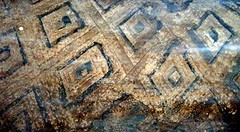
We looked at Alexander’s Temple. Bahariya is a bit miffed that Alexander’s visit to Siwa Oasis is well known and much vaunted – but his visit to Bahariya seems almost unknown. He put his personal cartouche in the wall of his temple and he only used it rarely. It is not there at the moment as it was cut out to put in the Cairo Museum and no-one seems to know where it went!
We were taken into some odd areas of the town – into a yard and past a small house – and the ground of the hump in front of the house was pitted with holes. Each hole was a tomb, or a vertical chamber down to it. They had huge sarcophagus – sarcophagi?? Everywhere – lids off and pushed aside, and lids upside down. At one point in one tomb the only way through was to walk straight down the centre of a sarcophagus half full of sand. There were even piles fo bones still in some corners of side rooms. Tomb robbers have left them like this - not archaeologists.
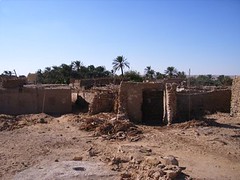
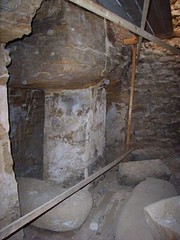
Most of these last dynasty Pharaonic tombs seemed to have a central square room with little tombs all around. They were brightly painted in five colours – black, white, dark reddish brown, a dark vivid yellow ochre and blue – a lightish chalky grey/blue. I was really interested to find iron ore next day in the colour of the red, and yellow ochre in the colour of the paint in the desert next day. I have no idea where the blue came from, but the colours were bright and fresh and the painting less fine but more vigorous than the work I have seen in tombs around Cairo.
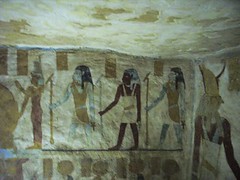
The gods carry ankhs as the sumbol of life
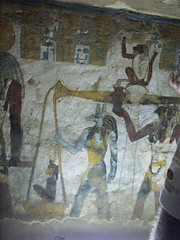
Collecting monkey urine while both Anubis and Horus hold the scales
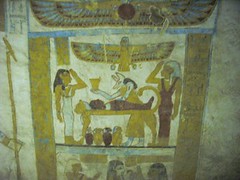
The mummification process on the wall of the tomb
We were even taken into a couple of the ‘tombs of the golden mummies’. They are closed to the public so it was a great treat. We had expected to see the things you see in the photos - long shelves, or small individual 'rooms' off to the side of a larger chamber like ones we had visited earlier in the trip.
We had to climb down into the tombs and crawl. I still can’t believe I did this. I don’t like heights, and I don’t like being underground. This required both. There was a terrifying moment when I had to swing myself over a sheer drop of about twenty feet onto a ladder leaning on the corner of the tomb. Then I had to climb down to the bottom. The last two rungs were much further apart – and the bottom rung was about four feet from the ground. I have short legs Getting down was no big deal as I just dropped. Getting up was more complicated. Among the odd debris on the floor was a big block of stone at the bottom of the ladder. Bob suggested I put my foot on that first to give myself a bit of extra height – and it was a good idea and might have worked if it had been stone. Unfortunately it was a chunk of foam rubber.
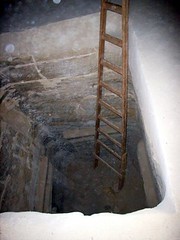
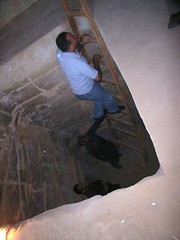
The entrance tunnel was not long, and our guides with their thighs of steel managed a ‘squat and waddle’ gait which worked and looked impressive – but I, and many others, chose to crawl. Much less dignified, and I worried a bit about the view the guy behind me had, but my thighs would never have coped.
It was a real surprise to emerge through the stone carved entrances to find that the tombs were still occupied by the original occupants. Each mummy was in place including their golden and plaster masks and bandages, and there were even tiny children. It felt like a privilege to be there, but faintly disturbing - as if I had accidentally wandered into somewhere I had no right to be! It was also very moving, a real sense of the presence of people of long ago. These tombs are not Pharaonic, despite their appearance. They are actually Roman period and share a lot with other tombs of the Roman time. The mummies are all local people, and although the gold and plaster masks and chest pieces look Pharaonic, they did not remove organs before mummification and put them into canopic jars like the time of the Pharaohs. Nor did they have the mouth opening ceremony, which inserts an ankh into the mouth to allow the soul to leave. However, the bodies were dried with salt for a month before wrapping. Unlike the Pharaonic tombs of the last dynasty which we had seen first, these tombs were not painted.
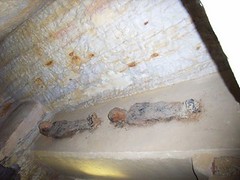
Children in the tomb - so touching I could have cried
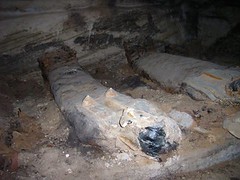
Golden Mummies in the tomb - note the golden chest plates, and her tiny breasts
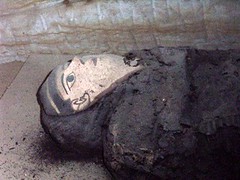
At peace under her mask
It was a brilliant day, and ended with a party – a local band and dinner in a ‘tent’ erected in the garden – permanent cane structure outside, tent linings inside, low tables around the walls, great local food and a dancer who had to be seen to be believed. Two wombats in a bag springs to mind. Two pigs in a gunny sack was a suggestion from an American friend. It was a local dance called the dance of the camel walk. Imagine a man in a long grey robe dancing with a long pole (horizontal unlike the usual version of pole dancing) and moving delicately and rhythmically from foot to foot very lightly, but with his back to you. I suspect that the idea is like belly dancing – which I always think should be called bottom dancing. In belly dancing the buttocks are firmly outlined and rounded with a scarf around the hips. I have now realised that this holds the buttocks together. This gentleman managed to work his quite independently of each other – it was just amazing. Because the clothes were loose it was all sinuous suggestion, rather than outrageous – but my husband kept averting his eyes and muttering boyish things, but had no problems watching a gorgeous member of the audience who got up to join him and belly danced!
I think it is a boy thing.
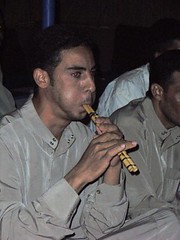
The pipes that kept getting longer and longer
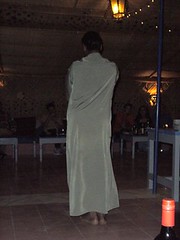
Impossible to photograph without motion
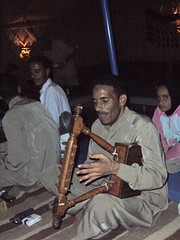
A local instrument whose name I have forgotten - made in the carpenter's shop
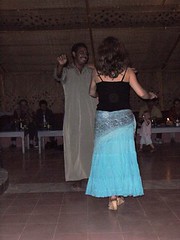
Tha guest who bellydanced with the Camel Walk dancer
We traveled with a group of good friends – Canadians and Americans – and stayed in a hotel in the town of Bawiti, in the Oasis of Bahariya. It is called the International Hot Springs Hotel – and it was great. It is run by a German, Peter Firth, and his mother and Japanese wife Miharu. I still find it astounding that anyone would see the potential for a hotel of this standard in an area like this oasis. If you think of a group of very simple and poor people, and try to imagine organizing a building of this standard complete with working western plumbing and reliable food – well the difficulties would have floored me at the very first stage.

The design of the hotel is beautiful with lots of rooms in unusual shapes – our room was a hexagon, with one side elongated to form the bathroom in the narrower extension.
Best of all is the pool room – and I am not talking about billiards! Every afternoon they fill this freshly with water from the Bahariya hot spring (don’t worry – I am sure the water taken out is used to irrigate the garden or nearby dates). The water comes out of the ground at 40 degrees Celsius – and it is almost painful to get into. I sat on the side with my feet in it and they were tingling in minutes. I didn’t actually swim but those who did said it was wonderful – hot at first, then tingling, then just incredibly relaxing. It is also an unusual colour because of the iron deposits in the area – a rich dark blood red.
We left Cairo at eight in the morning and arrived at the oasis at twelve, with time to check in and have our picnic lunch in the garden. We had planned a tour of the archaeological sites of the area first.


It is still Ramadan and it is really hard to do things in Ramadan. A message came from the guide (organised as a special treat to take us into the tomb of the golden mummies among other things). He was fasting, he was too tired and could not take us. However, he would make the keys available and the hotel manager would guide us instead.
This is a very Egyptian thing to happen. I am not sure what Peter Wirth thought of having to drop everything with a full hotel to take us out, but he and Miharu dropped everything and came. In fact, he was a superb guide. His archaeological knowledge was faultless, and when he didn’t know something he said so and didn’t waffle.
In the museum I quite unknowingly took a photo of part of one of the golden mummies as I was fascinated by the log cabin bandaging on them. The guard stopped me quickly with a ‘no photo’ so I put the camera away. However – I was not altruistic enough to delete the photo – bad, through glass and poorly lit – so here it is! I love the oblique parallelogram block shape and may make a quilt just like this in the same neutrals one day.

We looked at Alexander’s Temple. Bahariya is a bit miffed that Alexander’s visit to Siwa Oasis is well known and much vaunted – but his visit to Bahariya seems almost unknown. He put his personal cartouche in the wall of his temple and he only used it rarely. It is not there at the moment as it was cut out to put in the Cairo Museum and no-one seems to know where it went!
We were taken into some odd areas of the town – into a yard and past a small house – and the ground of the hump in front of the house was pitted with holes. Each hole was a tomb, or a vertical chamber down to it. They had huge sarcophagus – sarcophagi?? Everywhere – lids off and pushed aside, and lids upside down. At one point in one tomb the only way through was to walk straight down the centre of a sarcophagus half full of sand. There were even piles fo bones still in some corners of side rooms. Tomb robbers have left them like this - not archaeologists.


Most of these last dynasty Pharaonic tombs seemed to have a central square room with little tombs all around. They were brightly painted in five colours – black, white, dark reddish brown, a dark vivid yellow ochre and blue – a lightish chalky grey/blue. I was really interested to find iron ore next day in the colour of the red, and yellow ochre in the colour of the paint in the desert next day. I have no idea where the blue came from, but the colours were bright and fresh and the painting less fine but more vigorous than the work I have seen in tombs around Cairo.

The gods carry ankhs as the sumbol of life

Collecting monkey urine while both Anubis and Horus hold the scales

The mummification process on the wall of the tomb
We were even taken into a couple of the ‘tombs of the golden mummies’. They are closed to the public so it was a great treat. We had expected to see the things you see in the photos - long shelves, or small individual 'rooms' off to the side of a larger chamber like ones we had visited earlier in the trip.
We had to climb down into the tombs and crawl. I still can’t believe I did this. I don’t like heights, and I don’t like being underground. This required both. There was a terrifying moment when I had to swing myself over a sheer drop of about twenty feet onto a ladder leaning on the corner of the tomb. Then I had to climb down to the bottom. The last two rungs were much further apart – and the bottom rung was about four feet from the ground. I have short legs Getting down was no big deal as I just dropped. Getting up was more complicated. Among the odd debris on the floor was a big block of stone at the bottom of the ladder. Bob suggested I put my foot on that first to give myself a bit of extra height – and it was a good idea and might have worked if it had been stone. Unfortunately it was a chunk of foam rubber.


The entrance tunnel was not long, and our guides with their thighs of steel managed a ‘squat and waddle’ gait which worked and looked impressive – but I, and many others, chose to crawl. Much less dignified, and I worried a bit about the view the guy behind me had, but my thighs would never have coped.
It was a real surprise to emerge through the stone carved entrances to find that the tombs were still occupied by the original occupants. Each mummy was in place including their golden and plaster masks and bandages, and there were even tiny children. It felt like a privilege to be there, but faintly disturbing - as if I had accidentally wandered into somewhere I had no right to be! It was also very moving, a real sense of the presence of people of long ago. These tombs are not Pharaonic, despite their appearance. They are actually Roman period and share a lot with other tombs of the Roman time. The mummies are all local people, and although the gold and plaster masks and chest pieces look Pharaonic, they did not remove organs before mummification and put them into canopic jars like the time of the Pharaohs. Nor did they have the mouth opening ceremony, which inserts an ankh into the mouth to allow the soul to leave. However, the bodies were dried with salt for a month before wrapping. Unlike the Pharaonic tombs of the last dynasty which we had seen first, these tombs were not painted.

Children in the tomb - so touching I could have cried

Golden Mummies in the tomb - note the golden chest plates, and her tiny breasts

At peace under her mask
It was a brilliant day, and ended with a party – a local band and dinner in a ‘tent’ erected in the garden – permanent cane structure outside, tent linings inside, low tables around the walls, great local food and a dancer who had to be seen to be believed. Two wombats in a bag springs to mind. Two pigs in a gunny sack was a suggestion from an American friend. It was a local dance called the dance of the camel walk. Imagine a man in a long grey robe dancing with a long pole (horizontal unlike the usual version of pole dancing) and moving delicately and rhythmically from foot to foot very lightly, but with his back to you. I suspect that the idea is like belly dancing – which I always think should be called bottom dancing. In belly dancing the buttocks are firmly outlined and rounded with a scarf around the hips. I have now realised that this holds the buttocks together. This gentleman managed to work his quite independently of each other – it was just amazing. Because the clothes were loose it was all sinuous suggestion, rather than outrageous – but my husband kept averting his eyes and muttering boyish things, but had no problems watching a gorgeous member of the audience who got up to join him and belly danced!
I think it is a boy thing.

The pipes that kept getting longer and longer

Impossible to photograph without motion

A local instrument whose name I have forgotten - made in the carpenter's shop

Tha guest who bellydanced with the Camel Walk dancer


1 Comments:
Fascinating trip Jenny. I'm not sure I could have made it through the tunnel, though!! You were fortunate to see tombs that are intact. So many have been destroyed.
Liz Needle
Post a Comment
<< Home